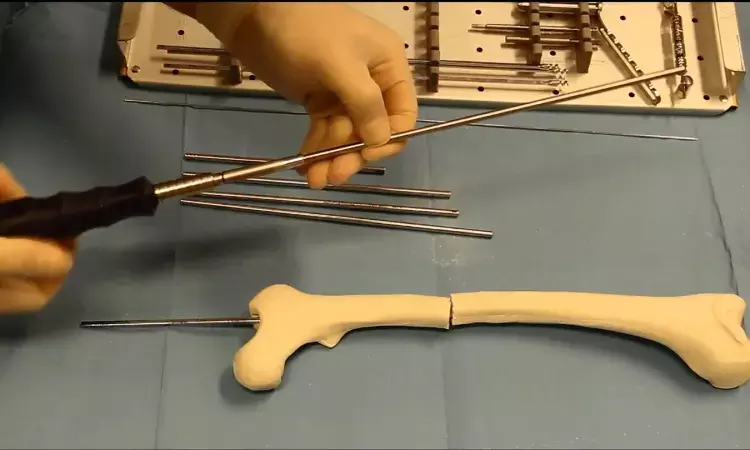- Home
- Medical news & Guidelines
- Anesthesiology
- Cardiology and CTVS
- Critical Care
- Dentistry
- Dermatology
- Diabetes and Endocrinology
- ENT
- Gastroenterology
- Medicine
- Nephrology
- Neurology
- Obstretics-Gynaecology
- Oncology
- Ophthalmology
- Orthopaedics
- Pediatrics-Neonatology
- Psychiatry
- Pulmonology
- Radiology
- Surgery
- Urology
- Laboratory Medicine
- Diet
- Nursing
- Paramedical
- Physiotherapy
- Health news
- Fact Check
- Bone Health Fact Check
- Brain Health Fact Check
- Cancer Related Fact Check
- Child Care Fact Check
- Dental and oral health fact check
- Diabetes and metabolic health fact check
- Diet and Nutrition Fact Check
- Eye and ENT Care Fact Check
- Fitness fact check
- Gut health fact check
- Heart health fact check
- Kidney health fact check
- Medical education fact check
- Men's health fact check
- Respiratory fact check
- Skin and hair care fact check
- Vaccine and Immunization fact check
- Women's health fact check
- AYUSH
- State News
- Andaman and Nicobar Islands
- Andhra Pradesh
- Arunachal Pradesh
- Assam
- Bihar
- Chandigarh
- Chattisgarh
- Dadra and Nagar Haveli
- Daman and Diu
- Delhi
- Goa
- Gujarat
- Haryana
- Himachal Pradesh
- Jammu & Kashmir
- Jharkhand
- Karnataka
- Kerala
- Ladakh
- Lakshadweep
- Madhya Pradesh
- Maharashtra
- Manipur
- Meghalaya
- Mizoram
- Nagaland
- Odisha
- Puducherry
- Punjab
- Rajasthan
- Sikkim
- Tamil Nadu
- Telangana
- Tripura
- Uttar Pradesh
- Uttrakhand
- West Bengal
- Medical Education
- Industry
Novel Low Cost Telescopic Nail available for Long Bone Fracture Treatment in Osteogenesis Imperfecta Children

Telescopic nailing and intermittent doses of bisphosphonates are now considered the standard treatment for preventing long bone pathological fractures in osteogenesis imperfecta (OI) children. Even though the telescopic nail designs have evolved over time, we are yet to get an affordable, worldwide uniformly and easily available, surgeon-friendly telescopic nail with good rotational stability.
Karthick Rangasamy et al designed a telescopic nail with modifications in Küntscher nail (outer, hollow component) and square nail (inner, solid component). The distal end of the square nail has a slot to allow locking in the distal epiphysis using a threaded K wire. The interlocking geometry between the two nails allows reasonable rotational control while allowing only longitudinal movements. This novel, low-cost, rotationally stable telescopic nail design is a good alternative to existing telescopic nails in the market, especially for children from low and middle-income countries (LMIC) where affordability and uniform availability are a concern.
Design of the implant:
The telescopic nail design consists of a Küntscher nail which acts as an outer hollow (female) component, and an ulnar square nail which acts as an inner solid (male) component.
Solid component: The configuration of a square nail within a clover-leaf nail imparts rotational stability to some extent due to the interlocking geometry/ design. The distal end of the nail is modified, and it is flattened to accommodate a distal locking slot to allow a passage of 1.6 mm Kirchner (K) wire.
Hollow component: The modification was done on the nail's proximal end to bear a hook/flange that will get embedded into the trochanteric apophysis to impart the proximal purchase on the cartilaginous portion of the trochanteric apophysis.
This telescopic nail can be used in both the femur and tibia. The authors described the surgical procedure for a malunited femur following OI-associated pathological fractures using a case example in the article published in Indian Journal of Orthopaedics. The follow-up radiograph at one year showed telescoping between the male and female components.
The authors shared the below pearls:
1. Do not use power reamer as the bone is fragile and brittle and may splinter with power tools.
2. Use a bone holding forceps (blunt serrated) to hold the fragments near the osteotomy site both proximally and distally. The purpose is to provide additional protection to avoid splintering while reaming and the bone holders are not removed till the entire construct is in place.
3. In patients with long standing bisphosphonate use, the diameter of canal is much less and the bone is more brittle and requires very gentle hand reaming.
The authors concluded that - this novel, low-cost telescopic nail combining clover-leaf and square nail design having reasonable rotational stability can be an alternative to other existing telescopic nails in the market, especially in LMIC, where affordability and uniform availability are a concern.
Further reading:
A Novel, Low Cost Telescopic Nail Design for Prevention and Treatment of Osteogenesis Imperfecta Associated Long Bone Pathological Fractures in Children
Karthick Rangasamy et al
Indian Journal of Orthopaedics (2022) 56:1277–1284
https://doi.org/10.1007/s43465-022-00617-4
MBBS, Dip. Ortho, DNB ortho, MNAMS
Dr Supreeth D R (MBBS, Dip. Ortho, DNB ortho, MNAMS) is a practicing orthopedician with interest in medical research and publishing articles. He completed MBBS from mysore medical college, dip ortho from Trivandrum medical college and sec. DNB from Manipal Hospital, Bengaluru. He has expirence of 7years in the field of orthopedics. He has presented scientific papers & posters in various state, national and international conferences. His interest in writing articles lead the way to join medical dialogues. He can be contacted at editorial@medicaldialogues.in.
Dr Kamal Kant Kohli-MBBS, DTCD- a chest specialist with more than 30 years of practice and a flair for writing clinical articles, Dr Kamal Kant Kohli joined Medical Dialogues as a Chief Editor of Medical News. Besides writing articles, as an editor, he proofreads and verifies all the medical content published on Medical Dialogues including those coming from journals, studies,medical conferences,guidelines etc. Email: drkohli@medicaldialogues.in. Contact no. 011-43720751


